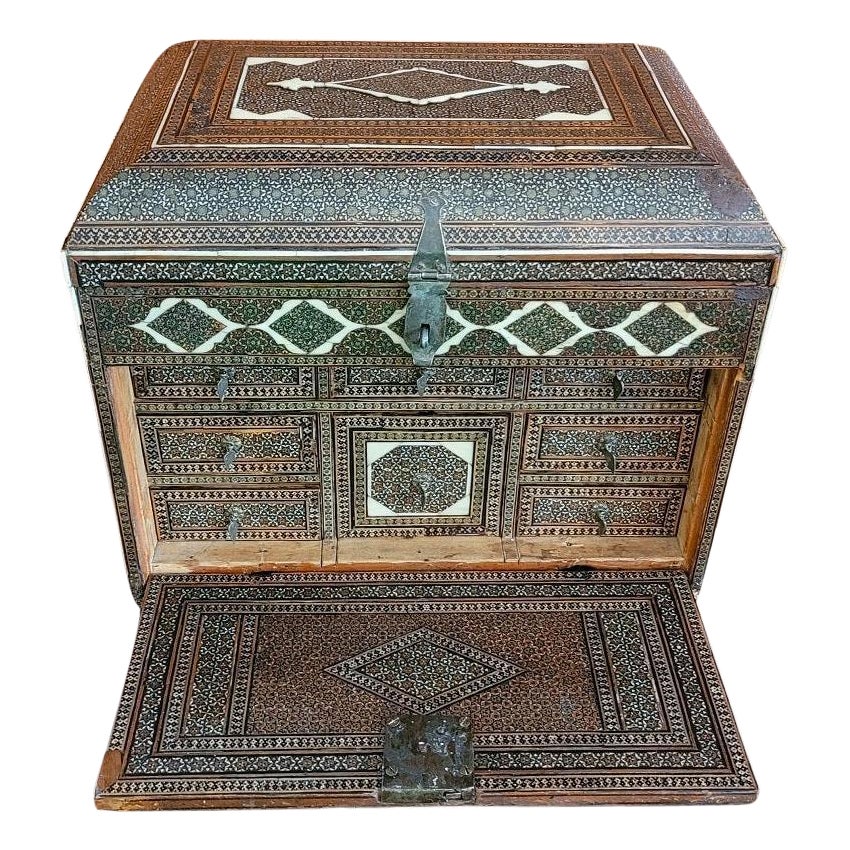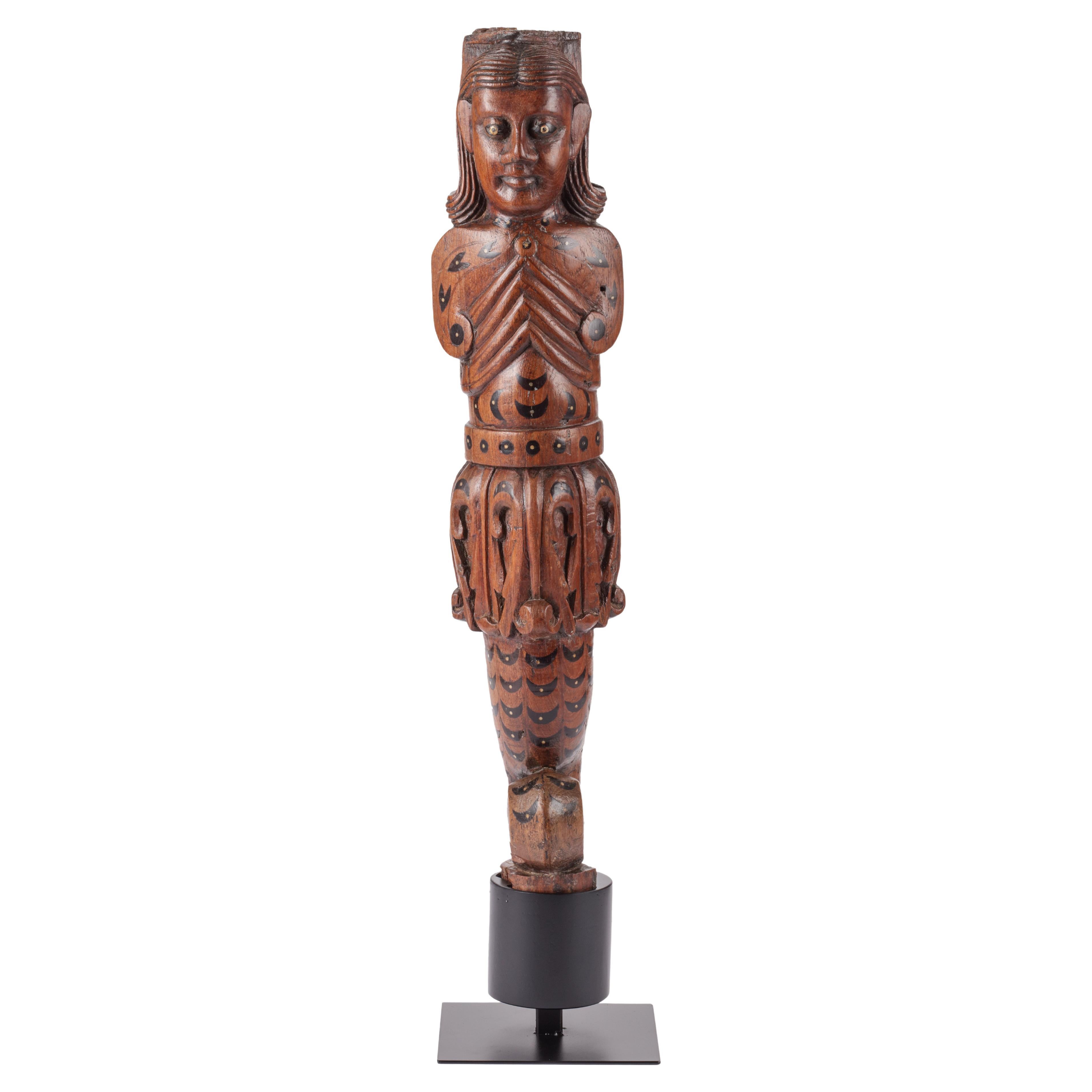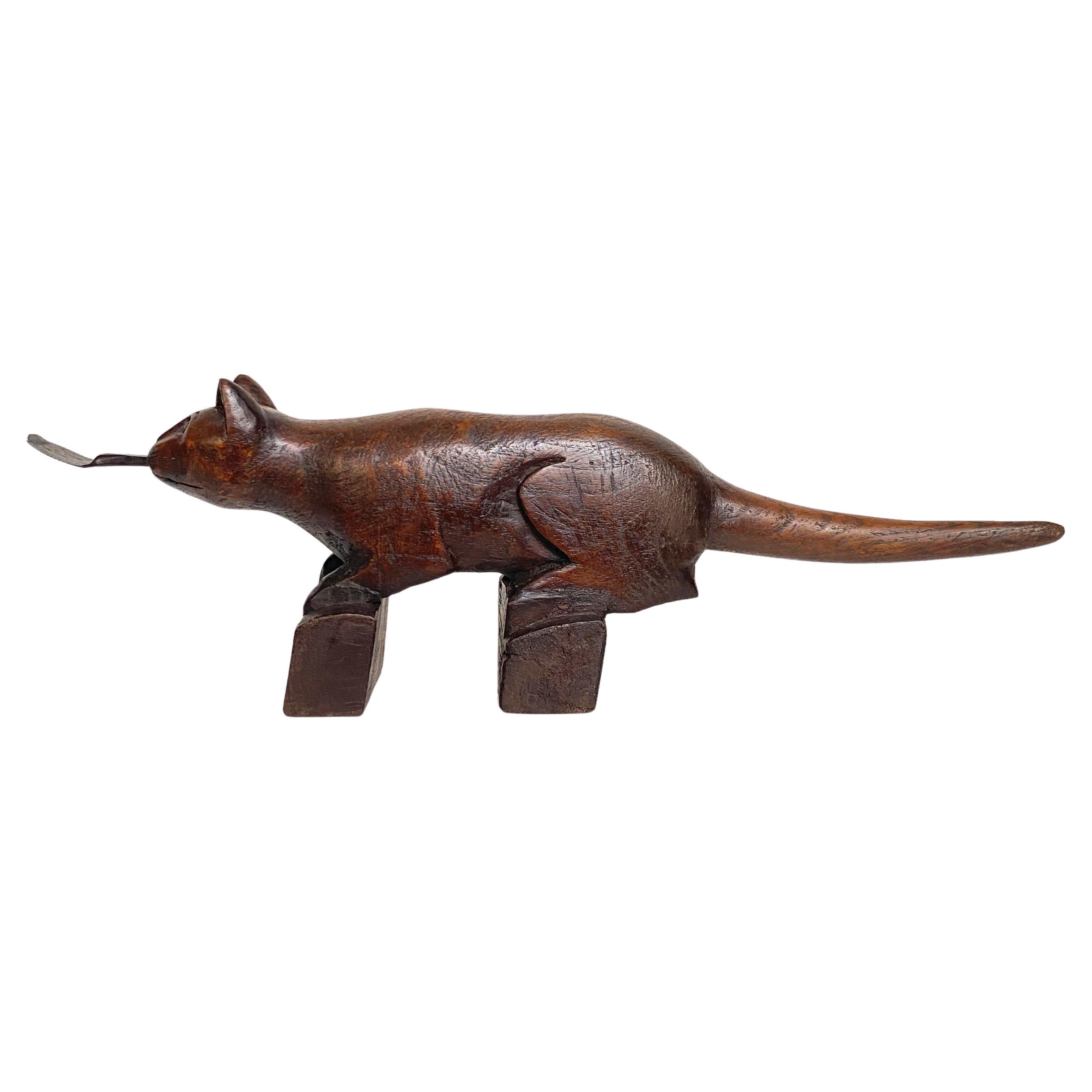Items Similar to Rare Indo-Portuguese Carved Iconographic Coconut
Want more images or videos?
Request additional images or videos from the seller
1 of 10
Rare Indo-Portuguese Carved Iconographic Coconut
About the Item
This rare and unusual object is a hand-carved coconut done in the Indian city of Goa, during the era of Portuguese colonization. The workmanship of the exquisite carving is superb in every way and shows the highest level of skill. In Goa, evidence of the visual arts can only be seen after the Jesuits arrived in the 1540s. This religious order played a pioneering role in encompassing all expressions of the human spirit. In art, they are irrevocably associated, in our minds, with the most original Indo-Portuguese religious sculptures – worked entirely by local craftsmen – who put their stamp on every piece they worked on. This is evident in the figures, flora and fauna depicted here, including garments, a Madonna and child, baskets of fruit, a man on horseback, hunting dogs and Hindu elders.
- Dimensions:Height: 6 in (15.24 cm)Width: 5 in (12.7 cm)Depth: 5 in (12.7 cm)
- Materials and Techniques:
- Place of Origin:
- Period:
- Date of Manufacture:18th/19th century
- Condition:Wear consistent with age and use. For an object of this age, the condition is remarkable, without any serious losses or damage. Shown on 18th C. Dutch silver stand (not included).
- Seller Location:Philadelphia, PA
- Reference Number:1stDibs: LU136922610932
About the Seller
4.9
Platinum Seller
These expertly vetted sellers are 1stDibs' most experienced sellers and are rated highest by our customers.
Established in 2003
1stDibs seller since 2015
872 sales on 1stDibs
Typical response time: 1 hour
- ShippingRetrieving quote...Ships From: Philadelphia, PA
- Return PolicyA return for this item may be initiated within 14 days of delivery.
More From This SellerView All
- Rare Antique Caucasian Seichur Rug with Dark Yellow Ground & Rare Triple BorderLocated in Philadelphia, PAAntique Caucasian Seichur rug with dark yellow ground and rare triple border. Finely hand-knotted with even medium wool pile on wool foundation. Very good ...Category
Antique Early 1900s Caucasian Tribal Caucasian Rugs
MaterialsWool
- Rare and Beautiful Wilhelm Kage Farsta BowlBy Wilhelm KageLocated in Philadelphia, PAExcellent hand thrown Kage Farsta stoneware bowl with interesting and nicely drippy matte finish yellow/ochre glaze. Hand signed and stamped, as shown. The world renown Wilhelm Kage ...Category
Vintage 1950s Swedish Mid-Century Modern Pottery
MaterialsStoneware
- 5x8.7 Ft Rare Antique Handmade Turkish Village RugLocated in Philadelphia, PAAn archaic and unique antique hand-knotted rug produced by the nomads in Central Anatolia by the turn of the century for their daily use rather than re-sale purpose. Lustrous wool pi...Category
Antique Early 1900s Turkish Tribal Turkish Rugs
MaterialsWool
- Rare Antique Caucasian Kazak Rug from Karabagh, Dated, 1812Located in Philadelphia, PAA rare and early Karabagh long rug from the first quarter of the 19th century featuring an all-over lattice work design with integrated shield and cross motifs in a subtle color pale...Category
Antique Early 19th Century Azerbaijani Kazak Caucasian Rugs
MaterialsWool
- Antique Caucasian Chi Chi Shirvan Rug. Rare Collectors CarpetLocated in Philadelphia, PAAntique Caucasian Chi Chi Shirvan rug. Finely hand-knotted with even medium wool pile on wool foundation. Very good condition. Washed professionally. Measures: 4 x 6.3 ft.Category
Antique Late 19th Century Caucasian Tribal Caucasian Rugs
MaterialsWool
- 4.2x7 Ft Rare Antique Turkish Magri 'Fethiye' Rug, Ca 1900Located in Philadelphia, PAAntique South West Anatolian rug from Fethiye or Telmessos, as in the ancient times, which used to be named as Makri in 19th century. Wool pile on wool foundation. Very good conditio...Category
Antique Late 19th Century Turkish Caucasian Rugs
MaterialsWool
You May Also Like
- 18 C, Indo-Portuguese Vargueno Mini CabinetLocated in Dallas, TXPresenting a fabulously rare 18c Indo-Portuguese Vargueno mini cabinet. Extremely rare, highly important and desirable colonial piece ! It is an In...Category
Antique Late 18th Century Indian Anglo-Indian Decorative Boxes
MaterialsBrass
- 16th-Century Indo-Portuguese Colonial Mother-of-pearl Gujarat CasketLocated in Amsterdam, NLAn exceptional Indo-Portuguese colonial mother-of-pearl veneered casket with silver mounts India, Gujarat, 2nd half of the 16th century, the silver mounts Goa or probably Lisbon Measures: H. 16 x W. 24.6 x D. 16.1 cm An exceptional Gujarati casket with a rectangular box and truncated pyramidal lid (with slopes on each side and a flat top) made from exotic wood, probably teak (Tectona grandis), covered with a mother-of-pearl mosaic. The tesserae, cut from the shell of the green turban sea snail (Turbo marmoratus, a marine gastropod) in the shape of fish scales, are pinned to the wooden structure with silver ball-headed nails. The casket is set on bracket feet on the corners. The masterfully engraved decoration of the silver mounts follows the most refined and erudite Mannerist repertoire of rinceaux and ferroneries dating from the mid-16th century. The high quality and refinement of the silver mounts and, likewise, the silver nails that replaced the original brass pins used to hold the mother-of-pearl tesserae in place indicate the work of a silversmith probably working in Lisbon in the second half of the 16th century. The Indian origin of this production, namely from Cambay (Khambhat) and Surat in the present state of Gujarat in north India, is, as for the last three decades, consensual and fully demonstrated, not only by documentary and literary evidence - such as descriptions, travelogues and contemporary archival documentation - but also by the survival in situ of 16th-century wooden structures covered in mother-of-pearl tesserae. A fine example is a canopy decorating the tomb (dargah) of the Sufi saint, Sheik Salim Chisti (1478-1572) in Fatehpur Sikri in Agra district in the state of Uttar Pradesh, north India. This is an artistic production, geometric in character and Islamic in nature, where usually the mother-of-pearl tesserae form complex designs of fish scales or, similar to the dishes also made using the same technique, with the thin brass sheets and pins, stylized lotus flowers. The truncated pyramidal shape corresponds, like their contemporary tortoiseshell counterparts also made in Gujarat, to a piece of furniture used in the Indian subcontinent within the Islamic world prior to the arrival of the first Portuguese. This shape, in fact, is very old and peculiar to East-Asian caskets, chests or boxes used to contain and protect Buddhist texts, the sutras. A similar chest is the famous and large reliquary chest from Lisbon cathedral that once contained the relics of the city's patron saint, Saint Vincent. Both match in shape, having the same kind of socle or pedestal and bracket feet, and in their engraved silver mountings, featuring the same type of refined, erudite decoration. Their differences lie in the silver borders that frame the entire length of the edges of the chest (both the box and the lid), pinned with silver nails, and on the lock plate, shaped like a coat of arms in the Lisbon example. Given the exceptional dimensions of the reliquary casket...Category
Antique 16th Century Indian Jewelry Boxes
MaterialsSilver
- Splendid Indo-Portuguese Colonial Sculpture of Nagini from Goa, 17th CenturyLocated in Amsterdam, NLA fine Indo-Portuguese inlaid teak wood figure of Nagini India, Goa, 17th century Measure: H. 55 cm (with stand, and with ring for wall hanging) The sculpture can be perceived as such but probably is one of four legs of an Indo-Portuguese contador...Category
Antique 17th Century Indian Jewelry Boxes
MaterialsEbony, Teak
- Andrianna Shamaris Antique Hand Carved Wood and Coconut Shell LadleBy Andrianna ShamarisLocated in New York, NYA unique wooden ladle with a half coconut shell attached, originally used for serving soup.The handle is a statue of a tribal man. Perfect perhaps to remo...Category
Early 20th Century Tribal Serving Pieces
MaterialsShell, Wood, Coconut, Reclaimed Wood
- Vintage Wooden Coconut Grater in Animal Form, ThailandLocated in Point Richmond, CAVintage Wooden Coconut Grater in Animal Form, Thailand A utilitarian implement commonly used in an Asian household. To use it, the coconut is cut in h...Category
20th Century Thai Folk Art Sculptures and Carvings
MaterialsWood
- Islamic Indo Persian Kulah Khud Helmet with Arabic InscriptionLocated in North Hollywood, CAIslamic Indo Persian kulah khud helmet with Arabic hand engravings. Hand forged, made of heavy tinned copper metal Middle eastern influence warrior helmet ...Category
Early 20th Century Indian Islamic Metalwork
MaterialsSteel, Metal
Recently Viewed
View AllMore Ways To Browse
Rare Stamps
Carved Stamp
Unusual Antique Objects
Portugal Art
Rare Antique Stamps
Portuguese Carved
The Coconut
Carved Hunting
Rare Antique Level
Hunting Dogs
Carved Dogs
Asian Carved Figures
Carved Fruit Basket
Hand Carved Dogs
Carved Basket Of Fruit
Indian Art 18th
Indian Basket Antique
Antique Indian Baskets Baskets





